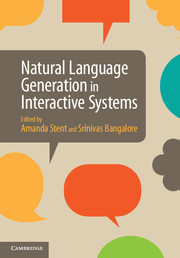Book contents
- Frontmatter
- Contents
- List of contributors
- 1 Introduction
- Part I Joint construction
- Part II Reference
- Part III Handling uncertainty
- Part IV Engagement
- 9 Data-driven methods for linguistic style control
- 10 Integration of cultural factors into the behavioral models of virtual characters
- 11 Natural language generation for augmentative and assistive technologies
- Part V Evaluation and shared tasks
- Author index
- Subject index
- References
9 - Data-driven methods for linguistic style control
from Part IV - Engagement
Published online by Cambridge University Press: 05 July 2014
- Frontmatter
- Contents
- List of contributors
- 1 Introduction
- Part I Joint construction
- Part II Reference
- Part III Handling uncertainty
- Part IV Engagement
- 9 Data-driven methods for linguistic style control
- 10 Integration of cultural factors into the behavioral models of virtual characters
- 11 Natural language generation for augmentative and assistive technologies
- Part V Evaluation and shared tasks
- Author index
- Subject index
- References
Summary
Introduction
Modern spoken language interfaces typically ignore a fundamental component of human communication: human speakers tailor their speech and language based on their audience, their communicative goal, and their overall personality (Scherer, 1979; Brennan and Clark, 1996; Pickering and Garrod, 2004). They control their linguistic style for many reasons, including social (e.g., to communicate social distance to the hearer), rhetorical (e.g., for persuasiveness), or task-based (e.g., to facilitate the assimilation of new material). As a result, a close acquaintance, a politician, or a teacher are expected to communicate differently, even if they were to convey the same underlying meaning. In contrast, the style of most human–computer interfaces is chosen once for all at development time, typically resulting in cold, repetitive language, or machinese. This chapter focuses on methods that provide an alternative to machinese by learning to control the linguistic style of computer interfaces from data.
Natural Language Generation (NLG) differs from other areas of natural language processing in that it is an under-constrained problem. Whereas the natural language understanding task requires learning a mapping from linguistic forms to the corresponding meaning representations, NLG systems must learn the reverse one-to-many mapping and choose among all possible realizations of a given input meaning. The criterion to optimize is often unclear, and largely dependent on the target application. Hence it is important to identify relevant control dimensions – i.e., linguistic styles – to optimize the generation process based on the application context and the user.
Information
- Type
- Chapter
- Information
- Natural Language Generation in Interactive Systems , pp. 207 - 226Publisher: Cambridge University PressPrint publication year: 2014
